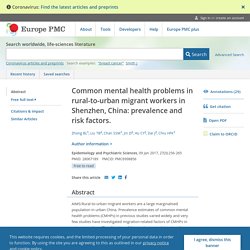

Google Maps. The largest migration in history: China's migrant workers. Universiade. Recurring international multi-sport event, organized for university athletes by the International University Sports Federation (FISU) The Universiade is an international multi-sport event, organized for university athletes by the International University Sports Federation (FISU).

The name is a combination of the words "University" and "Olympiad". The Universiade is referred to in English as the World University Games or World Student Games; however, this latter term can also refer to competitions for sub-University grades students. The Universiade is the largest multi-sport event in the world apart from the Olympic Games.[1] The most recent games were in 2019: the Winter Universiade was in Krasnoyarsk, Russia while the Summer Universiade was held in Naples, Italy. The 2021 Winter Universiade will take place in Lucerne, Switzerland between 11 and 21 December 2021,[2][3] and the 2021 Summer Universiade will be held in Chengdu, China between 18 and 29 August 2021. Precursors[edit] 1 The. 2011 Summer Universiade. The 2011 Summer Universiade, the XXVI Summer Universiade, was hosted in Shenzhen, Guangdong, China.

Bid selection[edit] The cities of Kazan, Russia, Kaohsiung, Taiwan, Shenzhen, China, Murcia, Spain, and Poznań, Poland were in contention for the Games. On 16 January 2007, FISU announced at the conference prior to the 2007 Winter Universiade, that the host would be Shenzhen.[1] With five candidates, it was the most competitive race to host a Universiade.[2] Edmonton, Alberta, Canada was also posed to make a serious bid, but withdrew.[3] Shenzhen. Prefecture-level and Sub-provincial city in Guangdong, People's Republic of China Shenzhen (; Chinese: 深圳; Mandarin pronunciation: [ʂə́n.ʈʂə̂n] ( Toponymy[edit] The earliest known recorded mention of the name zhen could date from 1410, during the Ming Dynasty.[28] Locals call the drains in paddy fields "zhen" (Chinese: 圳; lit. 'ditch, drain').

Shenzhen was named after a deep (Chinese: 深; lit. History[edit] Prehistory to Ming era[edit] Qing-era to 1940s[edit] To prevent a rebellion from Ming loyalists under Zheng Chenggong, better known as Koxinga, on the Chinese coast, the recently established Qing administration re-organized coastal provinces.[34] As a result, Xin'an County lost two-thirds of its territory to the neighboring Dongguan County and was later incorporated into Dongguan in 1669, though Xin'an was restored about 15 years later, in 1684. 1950s to 1970s[edit] Special Economic Zone (1980s–present)[edit] HK-Shenzhen Border. Βραζιλία: Διώχνουν τους φτωχούς από τα σπίτια τους με το πρόσχημα των Ολυμπιακών Αγώνων. Οι Ολυμπιακοί Αγώνες του 2016 θα διεξαχθούν στο Ριο ντε Τζανέιρο, στη Βραζιλία.

Η χώρα, όπως όλα δείχνουν, προετοιμάζεται από το 2009 για το μεγάλο γεγονός, όμως υπάρχουν και οι «παράπλευρες απώλειες», που αφορούν τις οικογένειες που ζουν στις φτωχογειτονιές της πόλης, τις γνωστές φαβέλες, από τις οποίες οι αρχές εκτοπίζουν με αναγκαστικές εξώσεις τους ανθρώπους με το πρόσχημα της κατασκευής έργων υποδομής. Αυτό τουλάχιστον ισχυρίζονται Μη Κυβερνητικές Οργανώσεις, που υπερασπίζονται τα δικαιώματα στέγασης των φτωχών του Ρίο ντε Τζανέιρο.
Κατεδαφίζουν τον οικισμό των Ρομά στο Χαλάνδρι - The Press Project - Ειδήσεις, Αναλύσεις, Ραδιόφωνο, Τηλεόραση. HK-Shenzhen Border. Οι σοσιαλιστές εργάτες. Οικονομικοί μετανάστες από την ύπαιθρο. Agricultural workers tend to their fields in 2002, overlooked by the fast-developing towers and factories of Guangzhou. Photograph: Richard Jones/Sinopix. Ο χώρος κοινωνικό αγαθό // θέματα και σχέσεις εξουσίας. Migrant Workers: A Vast Problem China Must Solve. China’s urbanization rate will hit 60% by 2018, a startling transformation from below 20% 40 years ago, reflecting China’s remarkable economic development.

There is, however, a dark underbelly of China’s urbanization - migrant workers – over 280 million people – almost one-third of urban populations. Second-class citizens in the cities that they themselves built by the strength of their backs and the sweat of their brows, migrant workers are one of China’s most pressing problems. How unfair that those who sacrificed so much to enable China’s economic miracle enjoy so little of its fruits - with limited social services, especially health care and education. Long-term, everyone recognizes that migrant workers must be integrated fully into city life. But how to pay for it?
The welfare of migrant workers having been an important concern in Chinese society. Shenzhen: The Migrant Experiment. A group of migrant workers in their cramped dormitories in Shenzhen, Guangdong province, China. May 2009. Βραζιλία - Ολυμπιακοί Αγώνες παράδειγμα για το bodily politics. Common mental health problems in rural-to-urban migrant workers in Shenzhen, China: prevalence and risk factors. AIMS:Rural-to-urban migrant workers are a large marginalised population in urban China.

Prevalence estimates of common mental health problems (CMHPs) in previous studies varied widely and very few studies have investigated migration-related factors of CMHPs in migrant workers. The objective of this study was to determine the prevalence and risk factors of CMHPs among Chinese migrant workers. METHODS:A random sample of 3031 migrant workers of ten manufacturing factories in Shenzhen, China, completed a standardised questionnaire containing socio-demographic and migration-related variables and the Chinese 12-item General Health Questionnaire (GHQ-12). A GHQ-12 score of three or higher was used to denote the presence of CMHPs. RESULTS:The prevalence of CMHPs was 34.4% in Chinese migrant workers.